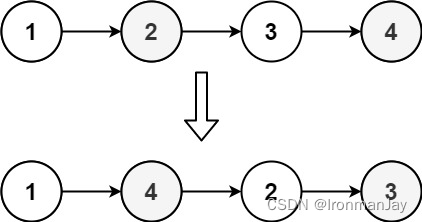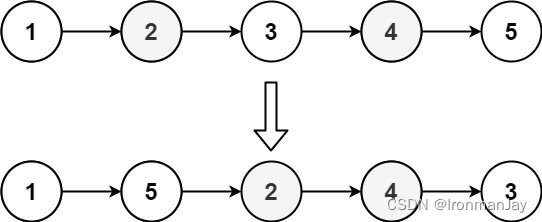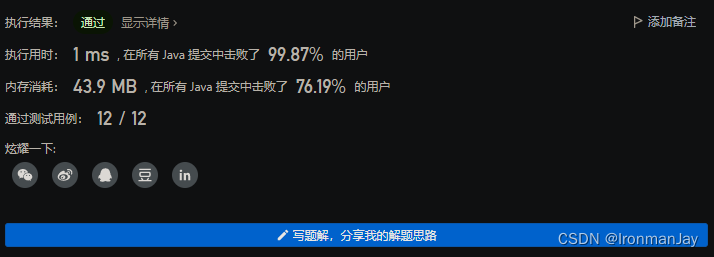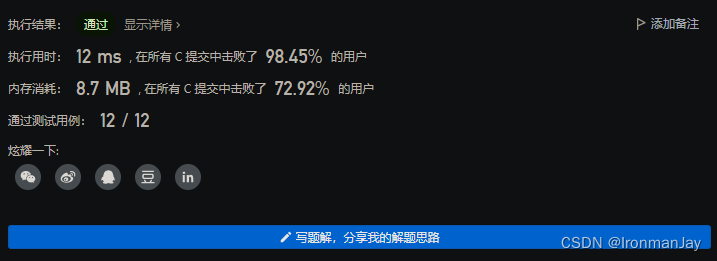一【题目类别】
- 双指针
二【题目难度】
- 中等
三【题目编号】
- 143.重排链表
四【题目描述】
- 给定一个单链表 L 的头节点 head ,单链表 L 表示为:
L0 → L1 → … → Ln - 1 → Ln
- 请将其重新排列后变为:
L0 → Ln → L1 → Ln - 1 → L2 → Ln - 2 → …
- 不能只是单纯的改变节点内部的值,而是需要实际的进行节点交换。
五【题目示例】
-
示例 1:

- 输入:head = [1,2,3,4]
- 输出:[1,4,2,3]
-
示例 2:

- 输入:head = [1,2,3,4,5]
- 输出:[1,5,2,4,3]
六【解题思路】
- 这道题思路很清晰,就是具体实现起来步骤较繁琐,但都是考察了链表的基础内容
- 首先通过快慢指针找到链表中点,将链表分割成前后两部分
- 然后将后半部分逆置
- 然后将两部分合并
- 最后返回结果即可
七【题目提示】
- 链表的长度范围为 [ 1 , 5 ? 1 0 4 ] 链表的长度范围为 [1, 5 * 10^4] 链表的长度范围为[1,5?104]
- 1 < = n o d e . v a l < = 1000 1 <= node.val <= 1000 1<=node.val<=1000
八【时间频度】
- 时间复杂度: O ( n ) O(n) O(n),其中 n n n 是链表的长度
- 空间复杂度: O ( 1 ) O(1) O(1)
九【代码实现】
- Java语言版
package DoublePointer;
public class p143_ReorderList {
int val;
p143_ReorderList next;
p143_ReorderList() {
}
p143_ReorderList(int val) {
this.val = val;
}
p143_ReorderList(int val, p143_ReorderList next) {
this.val = val;
this.next = next;
}
public static void main(String[] args) {
p143_ReorderList l1 = new p143_ReorderList(1);
p143_ReorderList l2 = new p143_ReorderList(2);
p143_ReorderList l3 = new p143_ReorderList(3);
p143_ReorderList l4 = new p143_ReorderList(4);
l1.next = l2;
l2.next = l3;
l3.next = l4;
l4.next = null;
reorderList(l1);
p143_ReorderList cur = l1;
while (cur != null) {
System.out.print(cur.val + " ");
cur = cur.next;
}
}
public static void reorderList(p143_ReorderList head) {
p143_ReorderList slow = head;
p143_ReorderList fast = head;
while (fast.next != null && fast.next.next != null) {
slow = slow.next;
fast = fast.next.next;
}
p143_ReorderList l1 = head;
p143_ReorderList l2 = slow.next;
slow.next = null;
l2 = reverse(l2);
merge(l1, l2);
}
public static p143_ReorderList reverse(p143_ReorderList head) {
p143_ReorderList pre = null;
p143_ReorderList cur = head;
while (cur != null) {
p143_ReorderList temp = cur.next;
cur.next = pre;
pre = cur;
cur = temp;
}
return pre;
}
public static void merge(p143_ReorderList l1, p143_ReorderList l2) {
p143_ReorderList temp1;
p143_ReorderList temp2;
while (l1 != null && l2 != null) {
temp1 = l1.next;
temp2 = l2.next;
l1.next = l2;
l1 = temp1;
l2.next = l1;
l2 = temp2;
}
}
}
- C语言版
#include<stdio.h>
#include<stdlib.h>
#include<stdlib.h>
struct ListNode {
int val;
struct ListNode *next;
};
struct ListNode* reverse_p143_ReorderList(struct ListNode* head)
{
struct ListNode* dummyHead = NULL;
struct ListNode* cur = head;
while (cur != NULL)
{
struct ListNode* temp = cur->next;
cur->next = dummyHead;
dummyHead = cur;
cur = temp;
}
return dummyHead;
}
void merge(struct ListNode* h1, struct ListNode* h2)
{
struct ListNode* temp1;
struct ListNode* temp2;
while (h1 != NULL && h2 != NULL)
{
temp1 = h1->next;
temp2 = h2->next;
h1->next = h2;
h1 = temp1;
h2->next = h1;
h2 = temp2;
}
}
void reorderList(struct ListNode* head)
{
struct ListNode* slow = head;
struct ListNode* fast = head;
while (fast->next != NULL && fast->next->next != NULL)
{
slow = slow->next;
fast = fast->next->next;
}
struct ListNode* l1 = head;
struct ListNode* l2 = slow->next;
slow->next = NULL;
l2 = reverse_p143_ReorderList(l2);
merge(l1, l2);
}
/*主函数省略*/
十【提交结果】
-
Java语言版

-
C语言版
